Access eROSITA data through ESASky!
We are happy to announce that eROSITA data is accessible from ESASky! Plus, two new features have been added: the ESA/Webb Outreach Images and ESA Virtual Assistant.
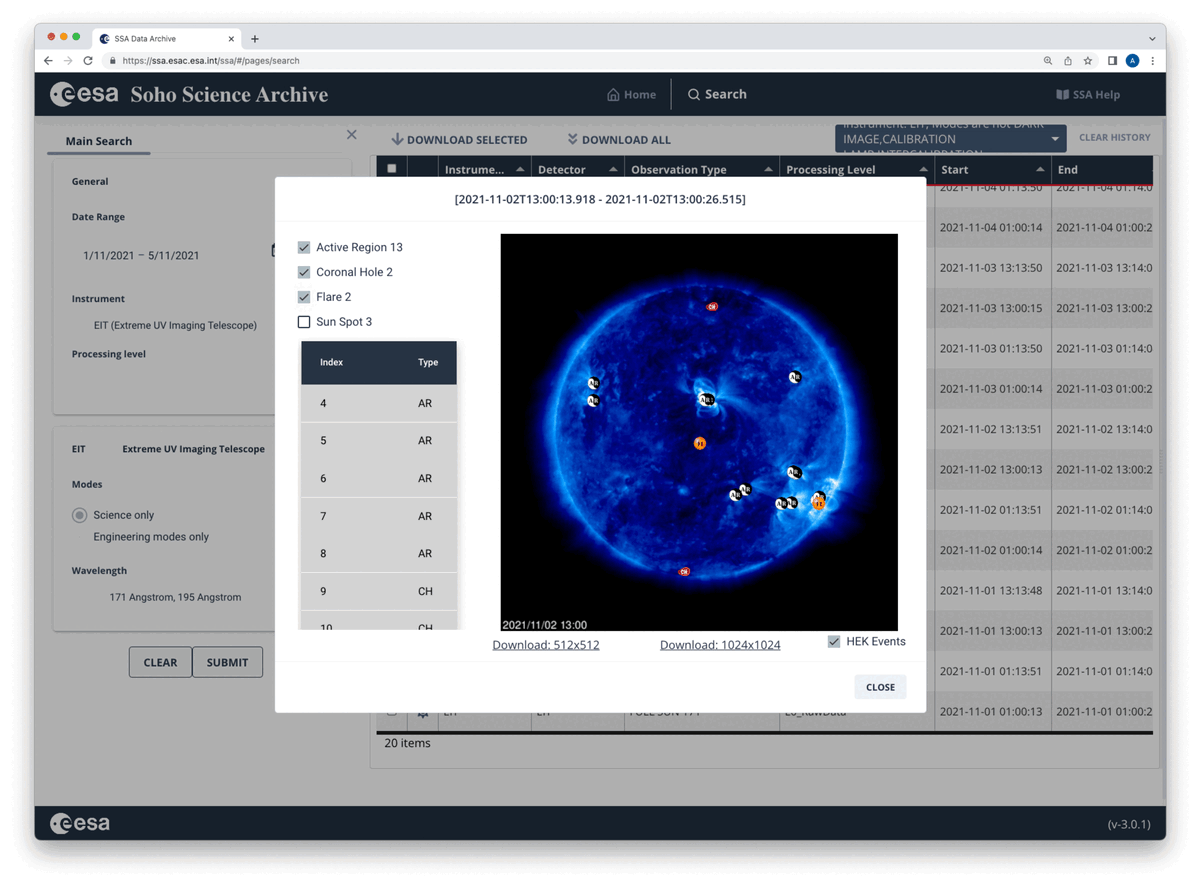
The SOHO project is pleased to announce the release early October 2022 of a brand-new version of the SOHO Science Archive (SSA) at the ESAC Science Data Centre (ESDC), European Space Agency, near Madrid, Spain. Work has been performed with the PI teams to easily search and filter science data for raw and calibrated processing levels along with mission-long bundles or engineering and operation mode datasets.
The Heliophysics Events Knowledgebase (HEK) database is progressively integrated in the archive, to enable event-focused science data searches. For example, as of the current release, HEK events are displayed on EIT quicklook plots (also known as 'postcards'; see the figure above).
Another feature of the archive is the ability to search, view and interact with key parameters measured by the CELIAS and COSTEP in-situ experiments. As an example, the figure below shows an interplanetary shock detected by CELIAS on October 31, 2021, associated with a halo CME and X-class X-ray flare on October 28, 2021. The solar wind speed, proton density and thermal speed plotted, after being extracted from the daily CELIAS file.
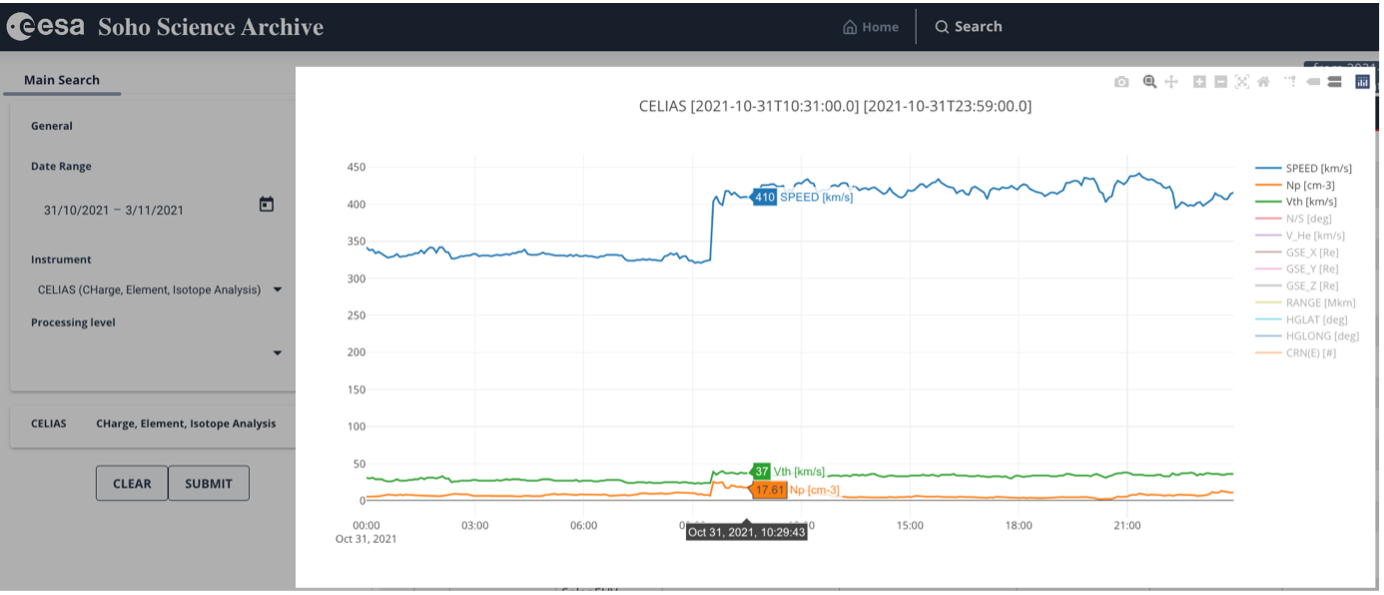 The current version (3.0) of the archive's user interface is based on the modern Angular library and the International Virtual Observatory Alliance (IVOA) standard Table Access Protocol for its command line access. And direct access to the SOHO archive TAP server tables (e.g., through the TOPCAT software), can be found from https://ssa.esac.esa.int/ssa-sl-tap/tap.
The current version (3.0) of the archive's user interface is based on the modern Angular library and the International Virtual Observatory Alliance (IVOA) standard Table Access Protocol for its command line access. And direct access to the SOHO archive TAP server tables (e.g., through the TOPCAT software), can be found from https://ssa.esac.esa.int/ssa-sl-tap/tap.
The archive is open access and does not require registration. We look forward to any questions or feedback to help us improve the archive. Happy science with this new archive!
Images: ESA/ESDC
We are happy to announce that eROSITA data is accessible from ESASky! Plus, two new features have been added: the ESA/Webb Outreach Images and ESA Virtual Assistant.
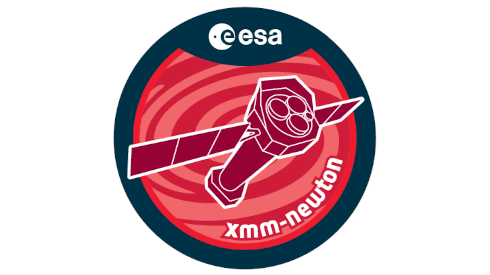
The latest serendipitous source catalogues, provided by the XMM-Newton Survey Science Centre have been included in the XMM-Newton Science Archive and ESASky.
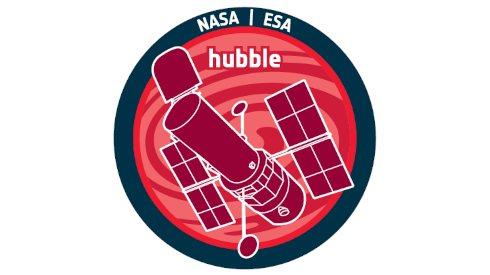
We are delighted to announce the release of a new version of the European Hubble Space Telescope (eHST) Science Archive.
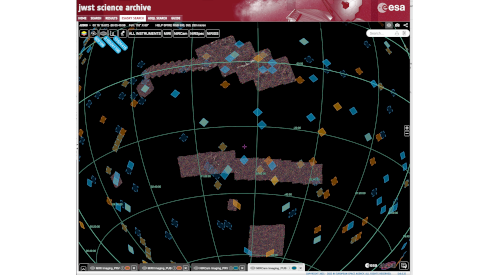
The Herschel Extragalactic Legacy Project is the first EC funded research project whose data sets and data products are available in the ESASky Legacy Archive.
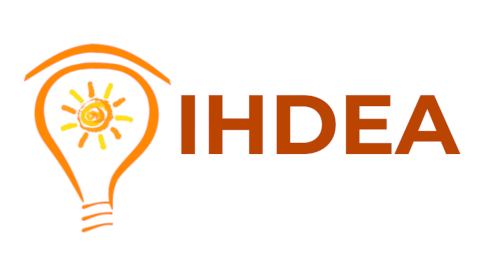
The 2022 annual International Heliophysics Data Environment Alliance meeting was recently organised by JAXA and Nagoya University and held virtually from 3 to 7 October 2022.
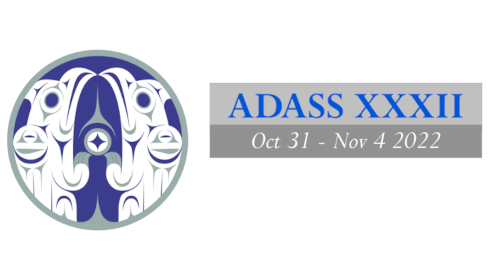
ADASS XXXII took place online with strong participation from the ESDC, who presented recent work on the INTEGRAL, JWST, HST and Euclid archives, ESASky, ESA Datalabs and on enabling data discovery in big datasets.
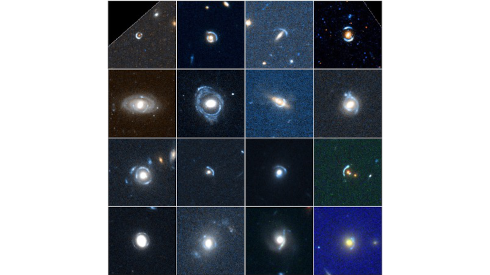
While searching for asteroids, citizen scientists have stumbled across strong gravitational lensing arcs.
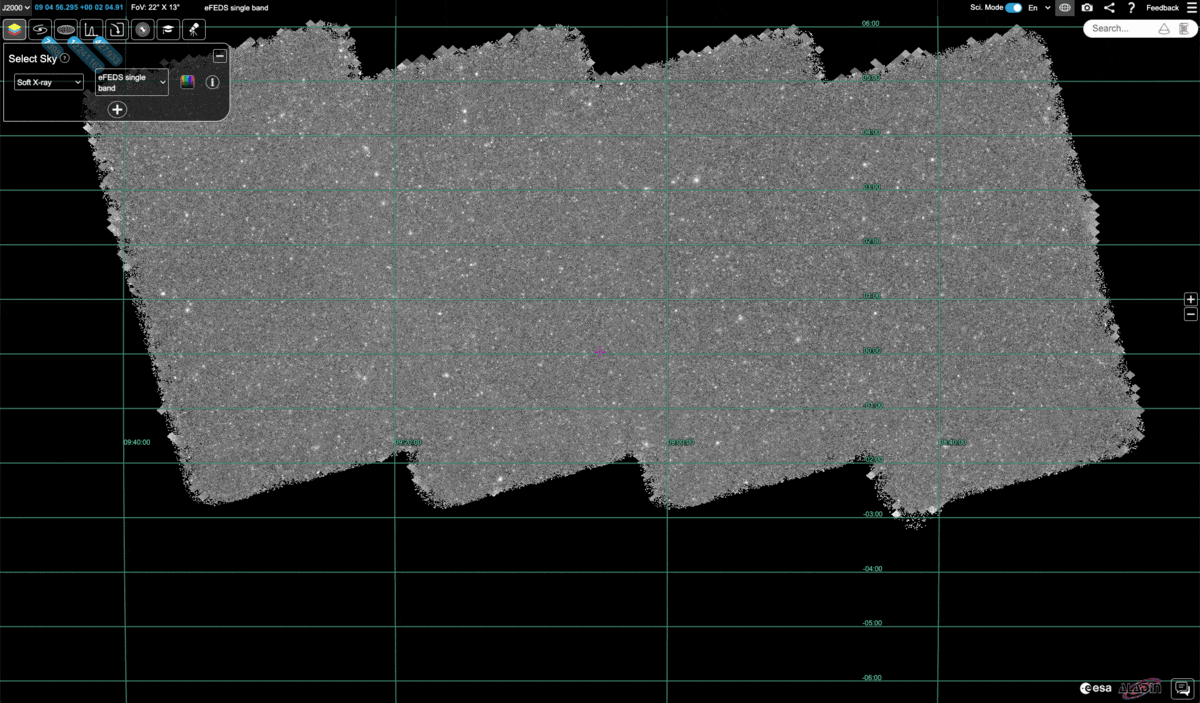
We are happy to announce that, since 1 December 2022, it is possible to inspect and download data from the eROSITA instrument via ESASky. This important milestone has been possible thanks to a collaboration between ESA's ESAC Science Data Centre (ESDC) and the eROSITA team at the Max-Planck Institute for extraterrestrial Physics (MPE) in Germany. eROSITA (extended ROentgen Survey with an Imaging Telescope Array) is a wide-field X-ray telescope operating onboard the SRG mission, and developed under the leadership of MPE. It is capable of delivering deep, sharp images over very large areas of the sky in the energy range ~0.2-8 keV.
The eROSITA data available in ESASky consists of data from the eROSITA Early Data Release (EDR), including all EDR Observations, where users can visualise the footprints of the observations in the sky, inspect the corresponding metadata and download the data. Additionally, two HiPS (Hierarchical Progressive Survey) sky maps of the eFEDS (eROSITA Final Equatorial Depth Survey) region, one colour HiPS and one single band 0.2-2.3 keV HiPS are available, along with four catalogues: the eFEDS main catalogue (almost 28,000 X-ray sources detected in the 0.2-2.3 keV band in the eFEDS region), the eFEDS hard catalogue (X-ray sources detected in the 2.3-5 keV band in the eFEDS region), the eta Chamaeleontis main catalogue and the eta Chamaeleontis hard catalogue.
The next release (DR1) of the eROSITA all-sky survey data is planned by MPE for next spring (around April 2023). It is anticipated that one (or more) all-sky maps and all-sky catalogues from DR1 will be included in ESASky later in the year.
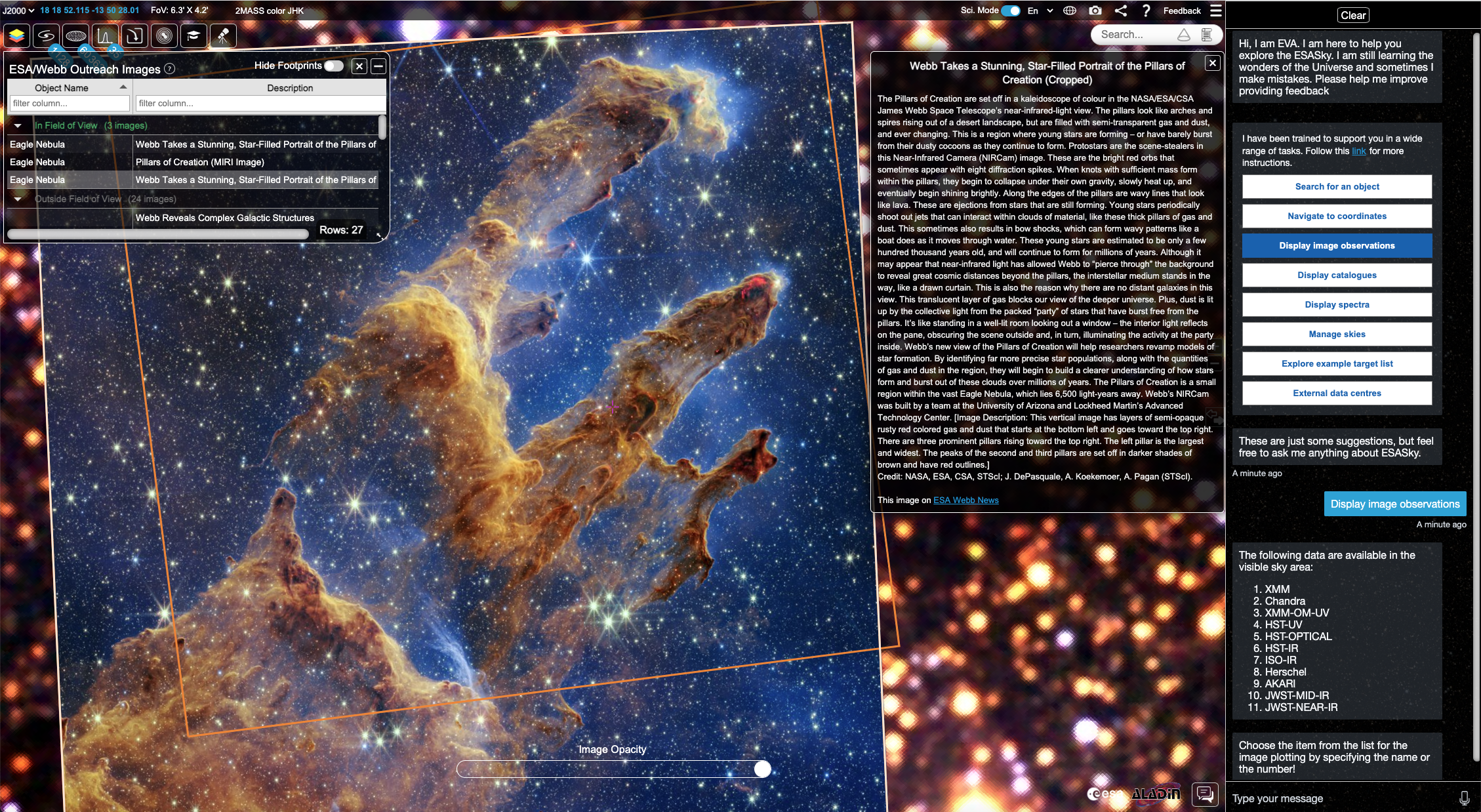 In other news, the LAMOST data and XMM-Newton serendipitous source catalogues have been updated in ESASky to the latest data releases. In collaboration with the China-VO team at the Chinese Academy of Sciences, ESASky released the LAMOST spectra and catalogues from the Eighth Data Release (DR8), on the day of the data release, 30 September 2022. The DR8 dataset includes 16.6 million spectra (obtained from October 2011 to June 2020) and 7.91 million sets of stellar spectral parameters. For details on the XMM-Newton serendipitous source catalogues, see the XMM-Newton Science Archive article.
In other news, the LAMOST data and XMM-Newton serendipitous source catalogues have been updated in ESASky to the latest data releases. In collaboration with the China-VO team at the Chinese Academy of Sciences, ESASky released the LAMOST spectra and catalogues from the Eighth Data Release (DR8), on the day of the data release, 30 September 2022. The DR8 dataset includes 16.6 million spectra (obtained from October 2011 to June 2020) and 7.91 million sets of stellar spectral parameters. For details on the XMM-Newton serendipitous source catalogues, see the XMM-Newton Science Archive article.
Also added recently to ESASky are two new exciting features: the ESA/Webb Outreach Images feature and the ESA Virtual Assistant (both shown in the above image). The ESA/Webb Outreach Image feature has been developed in collaboration with the ESA/Webb team to incorporate the spectacular Webb images featured on the ESA/Webb website into the ESASky application (as is already done for ESA/Hubble images). Users can tour the Webb outreach images overlaid on the sky, read the explanation about each image and link to the appropriate ESA/Webb outreach image page. More information about the feature can be found here.
The ESA Virtual Assistant, or EVA for short, can be opened from the chat button at the bottom right of ESASky. It uses artificial intelligence and natural language processing to allow users to interact with ESASky using simple sentences (typed or spoken) that trigger the commanding of ESASky via its API. Currently, the virtual assistant has been programmed with a sufficient number of interactions to carry out most of the tasks that a typical user would do in the ESASky web interface. The virtual assistant is still in training, therefore, exposing it to a larger audience will allow us to train the neural network running behind the virtual assistant to understand more complex sentences and commands, opening new avenues for more advanced exploration of ESASky. Please try it and give us your feedback!
Images: ESA/ESDC
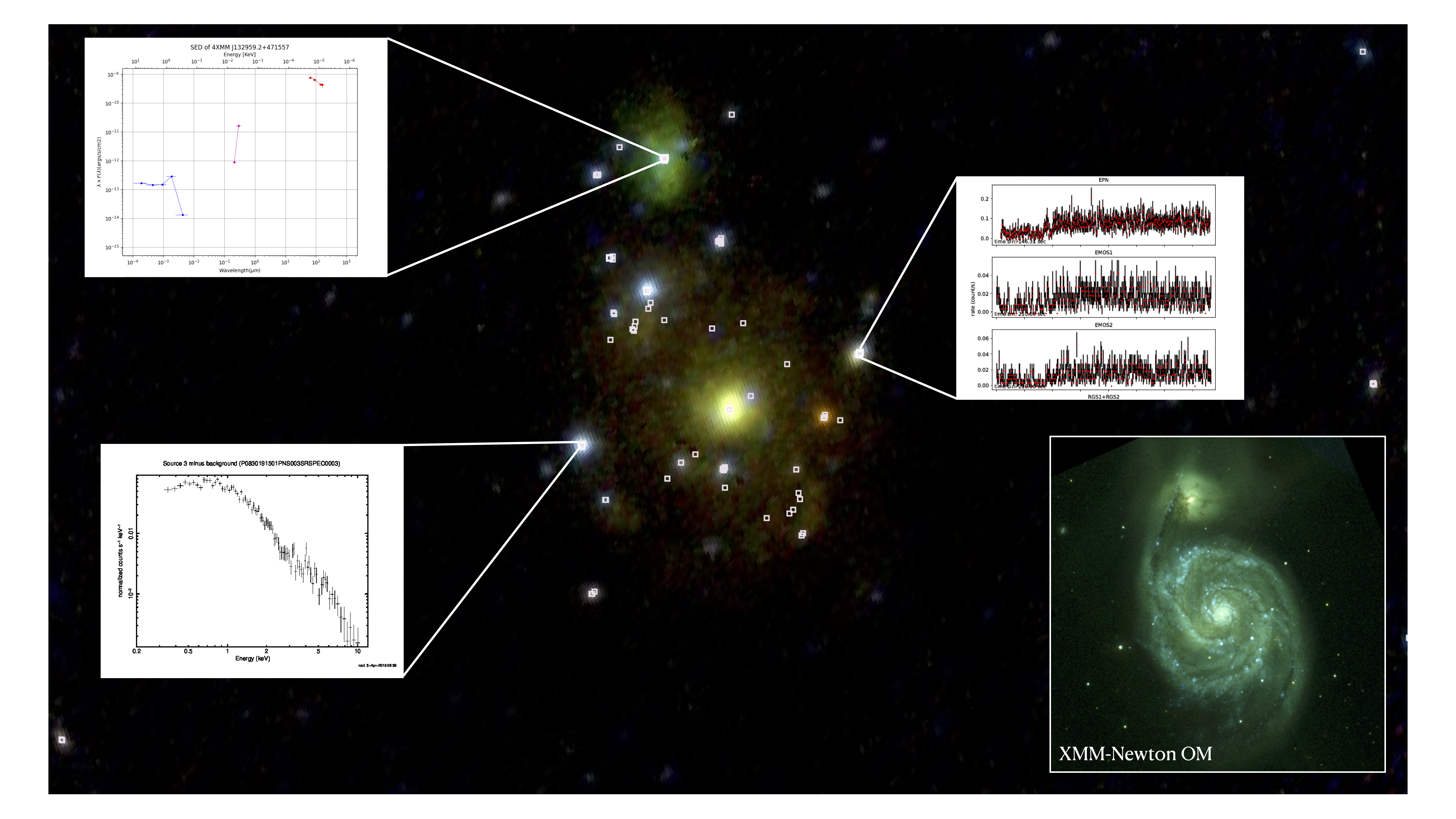
The latest serendipitous source catalogues, provided by the XMM-Newton Survey Science Centre have been included in the XMM-Newton Science Archive (XSA) and ESASky: Data Release 12 of the Fourth XMM-Newton Serendipitous Source catalogue (4XMM-DR12) built from individual observations and the 4XMM-DR12s EPIC Stacked catalogue built from overlapping observations to allow detection of even fainter objects. Based on one more year of data, the first catalogue now includes 939,270 detections, almost 44,000 more than -DR1, relating to 630,347 individual sources; the second catalogue contains 386,043 unique sources, more than 27,000 sources than the previous version. SED images, finding charts, lightcurves and spectra from these catalogues, together with other data in the 0.2-12 keV energy band are available via the XSA web interface and the Table Access Protocol. Both catalogues are also available in ESASky. The above image displays the ESASky view of the active galaxy M51 XMM-Newton observations. Brightest sources from the 4XMM-DR12 catalogue and several scientific products and the XMM-Newton OM image of the source are also shown.
The XMM-Newton scientific data can also be accesible through the python package astroquery. The function get_epic_spectra, included in the astroquery.esa.xmm_newton package, allows users to download the source and background spectra and ancillary files. The last release of astroquery now includes the most recent calibration matrices.
Image: ESA/ESDC
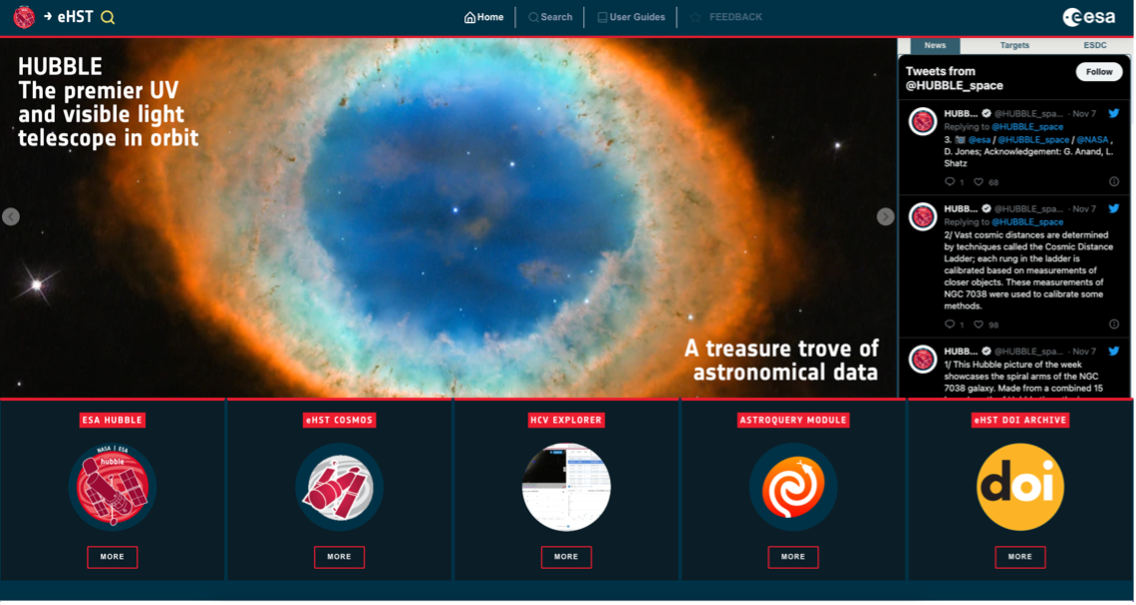
The European Hubble Science Archive, eHST, hosted at ESA's European Space Astronomy Centre in Madrid, has evolved within the ESAC Science Data Centre (ESDC) to a new infrastructure for the User Interface and backend services. Scientists will benefit of a renewed user experience just in time for the golden age of astronomical data exploration: over 1.5 million observations from Hubble Space Telescope, easy and intuitive to find, subject to combined with the Hubble related Catalogs, such as the Hubble Source Catalog.
Within the established partnership of NASA, ESA and CSA, eHST is making use of common procedures and tools in order to synchronise HST metadata and public data contents mirroring the Mikulski Archive for Space Telescopes (MAST) HST archive at the Space Telescope Science Institute (STScI).
The ESDC aims to provide the best experience to astronomers, to extract the maximum science return of this precious science data collection. This is the new set of functionalities that the new User Interface for the European Hubble archive offers:
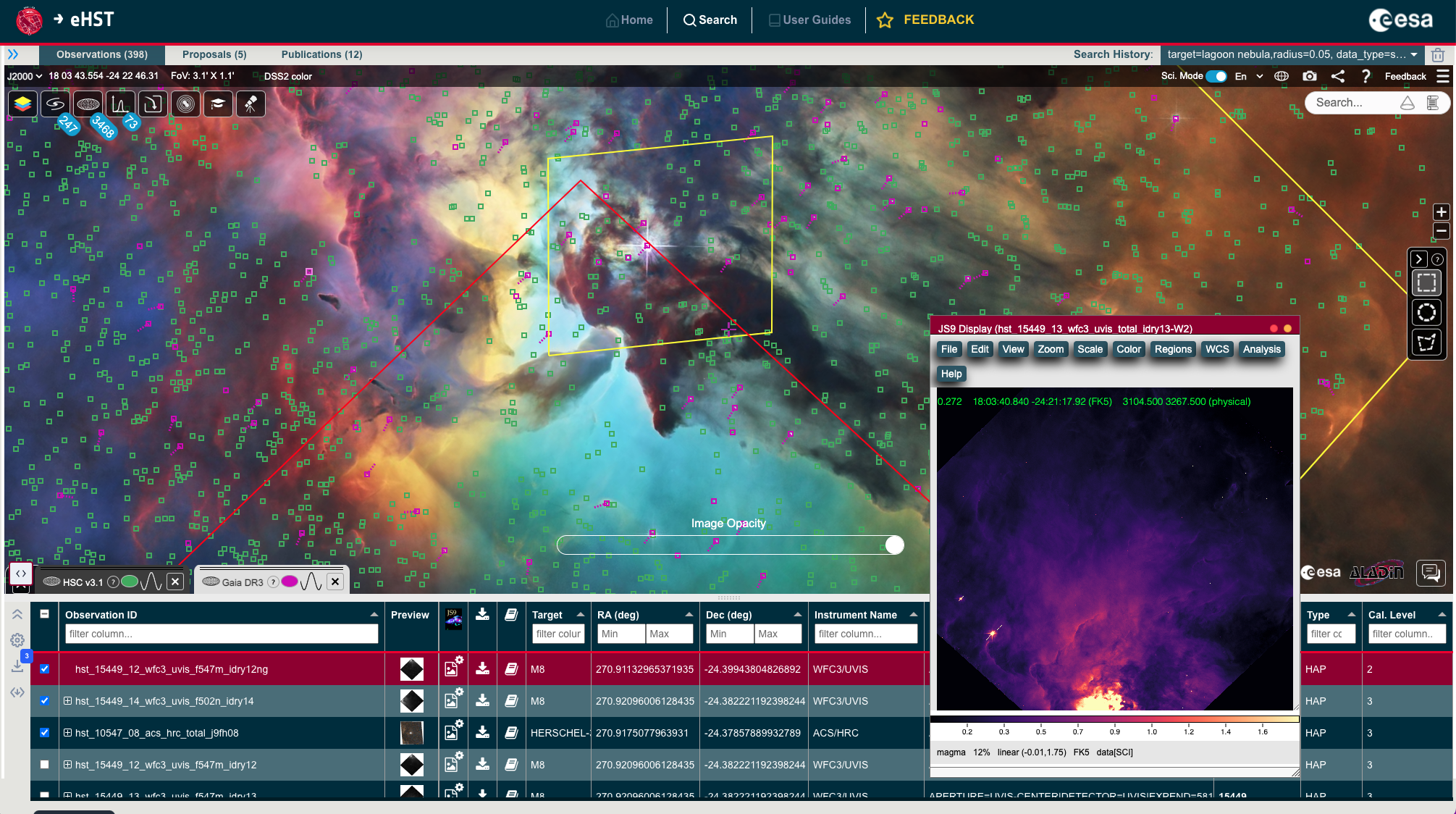 Users are encouraged to test the brand-new user interface for the European HST Science Archive and provide feedback!
Users are encouraged to test the brand-new user interface for the European HST Science Archive and provide feedback!

The Astronomy Archives User Group has recommended the preservation of user-supplied data products from EU-funded research projects (e.g. EU FP7 and EU Horizon 2020) that use ESA science missions data. With this task, the ESAC Science Data Centre is entrusted to foster the valorisation of these project outcomes and facilitate data aggregation and exploitation using discovery tools like ESASky.
The ESASky Legacy Archive solution is a Table Access Protocol service that provides the community with complete, self-standing catalogues and data collections from EU-funded astronomy projects, ensuring their long-term preservation. Accessible via VO archival tools like Topcat or astropy libraries like astroquery, this service provides a unified access point to data products and their successors that can be exposed by ESASky.
The Herschel Extragalactic Legacy Project (HELP) is the first European Commission Research Executive Agency funded research project (under the FP7-SPACE-2013-1 scheme) whose data sets and data products are made available in the ESASky Legacy Archive. The goal of this project was to produce a multi-wavelength comprehensive dataset of the galaxy population at high redshift. Following an approach akin to the Sloan Digital Sky Survey in the optical, this project has produced far infrared (FIR) photometry, photometric redshifts and Spectral Energy Distribution fitting of infrared galaxies using the ESA Observatory Herschel. We present a carefully selected collection of two extensive catalogues and a HiPS map from the HELP Data Release 1 (DR1). They comprise the 23 extragalactic fields that were observed with the PACS and SPIRE instruments aboard Herschel and complemented with optical and Spitzer MIPS observations.
The HELP project has been implemented using open science frameworks and principles of open source code, data, as well as open educational resources like example Jupyter Notebooks. Users will have these infrared resources within the ESASky platform to further exploit or combine with new and exciting observations produced by present-day observatories like Webb (see the image above) or surveys of the distant Universe like ESA Euclid.
Image: ESA/ESDC

The 2022 annual International Heliophysics Data Environment Alliance meeting was recently organised by JAXA and Nagoya University, held virtually from 3 to 7 October 2022. Various topics were discussed including distributed science platforms and research data cloud, metadata, data access protocols, DOI, AI/ML datasets and open science. All presentations are available online together with a recorded video of each session. The list of actions for the 2022-2023 period are listed here. If you are interested in any of these themes, please feel free to contact us.
Image: IHDEA
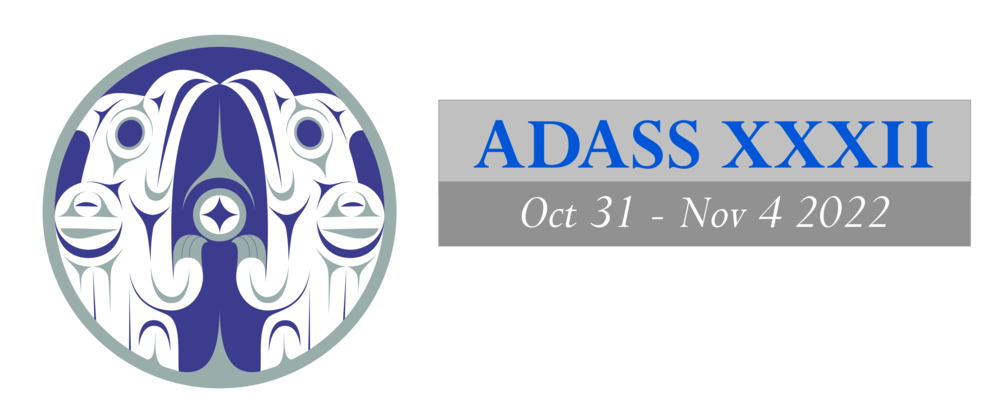
This year's Astronomy Data Analysis Software and Systems (ADASS) meeting took place online, from October 31 to November 4, 2022 and was hosted by the Canadian Astronomy Data Centre, the University of Toronto and the University of Victoria. Key topics at ADASS were, among others: big data, user interfaces and user experience, astro clouds and science platforms, software architecture and system design, reduction of the environmental footprint of astronomy. The ESDC participated in the conference with two invited talks about the Integral Archive: a new brand of science-oriented Science Archives at ESAC Science Data Centre and Enabling data discovery in big datasets, presented by Mónica Fernández and Pilar de Teodoro respectively; a focus demo on Optimising research with the European JWST Science Archive set of services presented by María Arevalo and Marcos López-Caniego; and a contributed talk on the ESA Virtual Assistant in ESASky: enabling archival data exploration via natural language processing presented by Marcos López-Caniego (ESDC) and Miguel Doctor Yuste (ESA Cosmos team). In addition, three posters were presented on starting collaborative research with the JWST in ESA Datalabs; on empowering science with the new European Hubble Space Telescope Science Archive; and on a sky portal for Euclid data: The Euclid scientific archive system.
Image: M. August
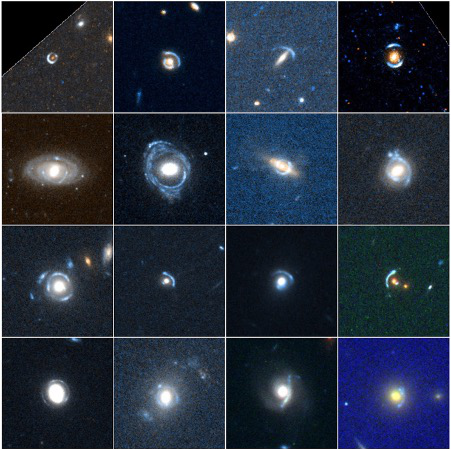
Having human eyes on the data can lead to surprising new discoveries. While searching for asteroids in the Hubble Asteroid Hunter project, citizen scientists have stumbled across strong gravitational lensing arcs which they had initially classified as asteroid trails. With the instructions and training provided by the science team, the volunteers tagged 2354 objects as possible strong gravitational lenses. Visually inspecting these objects, the science team found that 252 of them were indeed genuine strong gravitational lenses, which were not the target of the Hubble observations, but lying in the background of some other famous astronomical targets. Checking the existing publications on these objects in ESASky, the scientists found that 198 of them were new strong lenses, not previously reported by other studies.
This project led to an unbiased search for strong lenses with crowdsourcing in almost two decades of Hubble Space Telescope observations, available in the eHST archive. Instead of inspecting postage stamps of preselected galaxies with some criteria (for example, of massive elliptical galaxies) as was commonly done in previous lens searches, this citizen science project showed large field-of-view Hubble images to the public. As a result, the volunteers also found some exotic lens configurations: spiral and edge-on disc galaxies as lenses; sources lensed by galaxy bulges; and possible double source plane lenses. Moreover, the high resolution of the Hubble observations reveals tiny arcs and Einstein rings, which are not accessible from the ground.
 While the citizen scientists inspected over 45,000 Hubble images during a year, these cover only 27 square degrees of the sky. The upcoming ESA Euclid mission, to be launched next year, will image 15,000 square degrees of the sky with comparable resolution to Hubble. This study provides further evidence that Euclid will be able to find large samples of over 100,000 strong lenses during the six years of the mission. Given the scale of Euclid, using a citizen science approach to explore the entire Euclid dataset is not feasible on its own. Combining crowdsourcing with artificial intelligence on the other hand has a great potential to detect and validate strong lenses, as well as find exotic lenses in future large-scale surveys such as from Euclid or in James Webb Space Telescope archival images. This work also shows the benefits of exploring large archival datasets spanning decades in time, such as those hosted by the ESDC, to expand the horizons of future research.
While the citizen scientists inspected over 45,000 Hubble images during a year, these cover only 27 square degrees of the sky. The upcoming ESA Euclid mission, to be launched next year, will image 15,000 square degrees of the sky with comparable resolution to Hubble. This study provides further evidence that Euclid will be able to find large samples of over 100,000 strong lenses during the six years of the mission. Given the scale of Euclid, using a citizen science approach to explore the entire Euclid dataset is not feasible on its own. Combining crowdsourcing with artificial intelligence on the other hand has a great potential to detect and validate strong lenses, as well as find exotic lenses in future large-scale surveys such as from Euclid or in James Webb Space Telescope archival images. This work also shows the benefits of exploring large archival datasets spanning decades in time, such as those hosted by the ESDC, to expand the horizons of future research.
Find out more about this work in the article.
Hubble Asteroid Hunter is a citizen science project, developed as a collaboration between scientists at ESA, the ESDC, and Zooniverse. Launched in June 2019, it involved over 11,000 members of the public in the search for asteroids in HST archival observations spanning almost two decades. The combination of citizen science and an artificial intelligence algorithm trained on the volunteer classifications led to the finding of 1,701 asteroid trails in the Hubble images (such as that of the main belt asteroid 2001 SE101 crossing the Crab nebula), of which 1,031 were attributed to previously unknown asteroids. The asteroid findings were reported in the first publication of this project.
Images: Garvin, E. O., et al., 2022, A&A, 667, A141